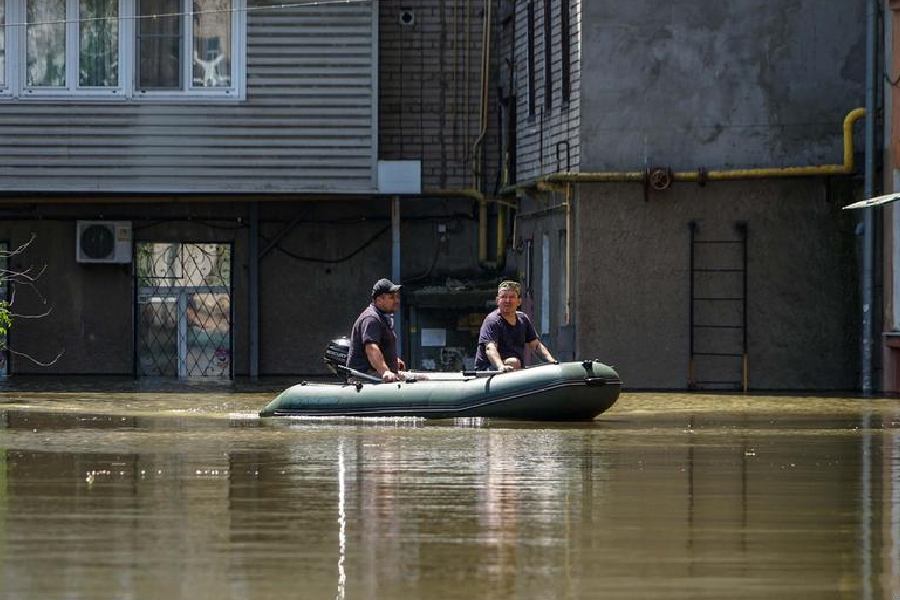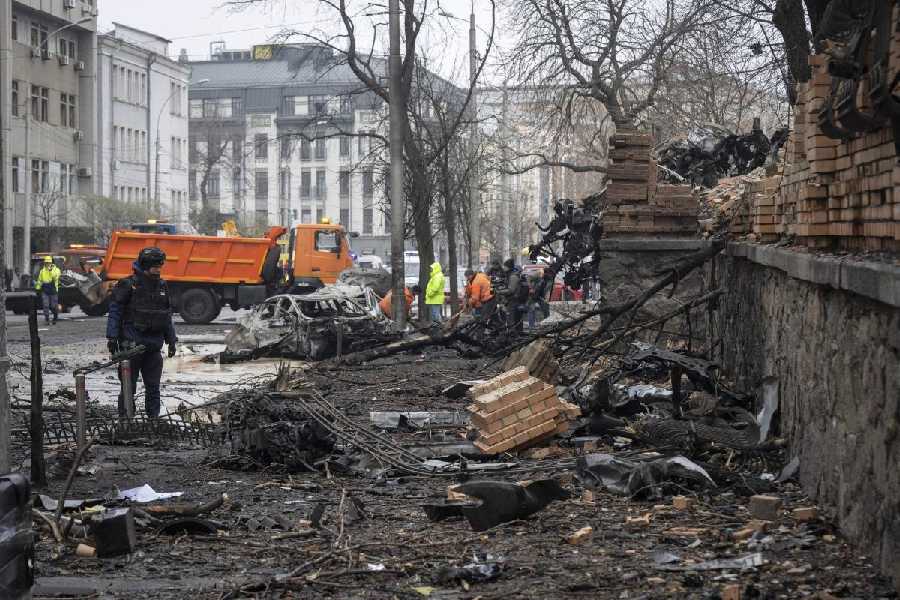On the morning of June 6, the world learned of the destruction of the Kakhovka hydroelectric power plant, built in the late 1950s, which had been controlled by Russian troops since the start of their invasion of Ukraine in February 2022.
According to Kyiv's version, which Moscow denies, the station was blown up during the night. As a result of the explosion, the dam broke, and the plant and the dam were destroyed. Water levels in the Kakhovka Reservoir began to drop rapidly, while the surrounding areas in the lower reaches of the Dnieper River, including Kherson, were flooded.
Below, a DW correspondent reports on what he experienced in Kherson over the past three days.
Morning of June 7
Dozens of stunned Kherson inhabitants stand under the World War II memorial and watch as giant poplars are carried are by the Dnieper River past the embankment towards the Black Sea. Two barges, torn from their anchors by the current, have drifted here.
Granite stairs descend from the monument to the embankment. For decades, they served as a venue for local open-air concerts. Now the bottom three flights are already under water, and the water keeps rising.
The faces of the townspeople who survived eight months of Russian occupation and half a year of shelling at the frontline are etched with confusion and shock. No one has seen anything like this before.
Maksym, a man in his 40s, says the potential destruction of the dam was not a new topic in conversations among Kherson residents. "The last time there was a lot of panic was in 2000, when everyone was afraid of a computer failure due to the Y2K problem," says Maksym, recalling the fear, which many Ukrainians shared, that a computer bug would cause power station failures. "The engineers explained that only the lower quarters of Kherson would be flooded."
He is now putting up a colleague from the local electricity supply company whose house in the Komyshany suburb was flooded a day ago.
"No, no, there was a time when we were already flooded a lot. I was five then, I think," said 78-year-old Maria, standing next to him. She seems to remember a large-scale flood in the distant past, but gets confused recalling the years and events.
Her son Ihor leads us along a narrow path between some houses closer to his mother's home, the roof of which now barely sticks out of the water. "Mom, you watered the tomatoes yesterday," the man jokes. The water would have to rise another 10-15 meters to reach his own house — so the family is going to stay there.
Meanwhile, a few kilometers downstream, the residents of Vorontsovska Street have been trapped since the morning: Overnight, the shoreline moved 500 meters inland from the river port building, flooding several blocks of high-rise buildings up to the second floor, and in some places even higher.
Afternoon of June 7
Rescuers, police officers, military personnel, journalists and volunteers who come to the city from all over the country gather on the new "shore" of Kherson. People have to be pulled out of high-rise buildings, and the rubber boats able to simply row up to windows and attics. Some people are rescued in their underwear, but apart from money and documents, they are not allowed to take many things with them anyway.
Nearly half of the volunteers and boats are rescuing pets. After the recent news about the deaths of animals at the zoo in Nova Kakhovka on the occupied left bank of the Dnieper, nobody wants to leave animals to die.
Morning of June 8
The water rises a few more meters, but still cannot completely flood the high banks of the Dnieper. It was already known that due to the topography, the right bank was only partially threatened by flooding.
However, the Kherson district of Korabel, located on an island, has now gone almost completely under water. The evacuation of the few residents who remained there after six months of merciless artillery shelling began when the first news of the destruction of the dam arrived. Now, by the third day, rescuers on boats seem to be searching only for animals among the houses.
The number of boats increases every hour. Kherson is a city of shipbuilders. Before the war there were several shipyards and a few yacht clubs here, and almost every resident of the coastal areas owned a motor boat.
But in November last year, the Russian army retreated to the left bank and seized all available watercraft. Now Ukrainian volunteers are trying to source more boats from across Ukraine. The boat has become a gateway to the city, though the Ukrainian military occasionally tries to seal off the town due to the threat of air and artillery strikes.
Noon, June 8
Ukrainian President Volodymyr Zelenskyy arrives in Kherson. After meeting the rescuers and the military, he visits the already flooded Korabelna Square. From here there is a bridge to the Korabel district on its island, but now it is of no use, since you can only get there by boat.
A few blocks to the north, we found a watercraft for ourselves — a small inflatable boat without a motor. It lies abandoned in an empty alley, so the three of us row slowly around someone's garden, and see a grocery kiosk, only visible by its sign sticking out of the water. There are no longer any people here or in the neighboring high-rise buildings.
Afternoon, June 8th
Shells start whistling overhead — Korabelna Square is being shelled from the left bank. It is difficult to explain this attack — the Ukrainian president left the place more than an hour ago, evacuation operations are ongoing, so the only potential targets could be rescuers, policemen, volunteers and journalists. After several explosions, nine were injured, including a volunteer from Germany.
We row to the yellow wall of a half-flooded two-story building, holding on to some cables so as not to be swept away by the current. One of the shells hits a house 30 meters from our boat, though fortunately the building is empty. Having waited a long time for the artillery from both sides to finally die down, we row back to the shore twice as fast.
Evening, June 8
The water stops rising.
June 9
The shelling continues, despite concerns expressed by the UN and more drastic statements from humanitarian organizations. According to satellite images and information from residents of the left bank, the flood actually forced the Russian army to move away from the Dnieper.
But the city is still within reach of artillery and some missile systems, and misses that strike civilian targets are becoming increasingly common in Kherson. On June 9, one of the projectiles hits a school near the shore, another strikes the roof of a nine-story building in the Shumensky district. Luckily there are no injuries.
But the flood also allows the Ukrainian military to make its way cautiously to the left bank, first to the town of Oleshky, which was almost completely flooded. Videos circulating on social media show locals sitting on rooftops awaiting rescue. Several groups of rescuers only manage to reach Oleshky from Kherson in heavy boats — rubber boats are simply washed away by the current.
But another problem has now arisen — the flood raised mines that the military used to defend the approaches to their positions for the past six months. After the first reports of boats exploding, the military is trying to limit rescue navigation or at least take control of this volunteer flotilla.
The water has now started to recede, but the water will not drop to previous levels, local ecologists say, so it will soon have to be pumped out of flooded homes. The local humanitarian center says that pumps and chemical agents for water purification are now the most urgent needs of the city in the coming months.










